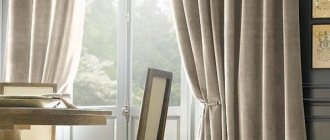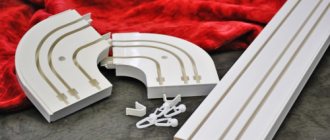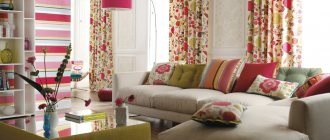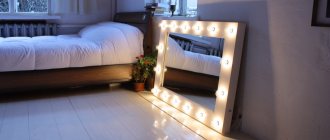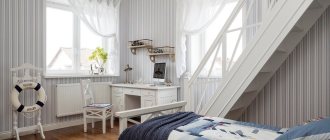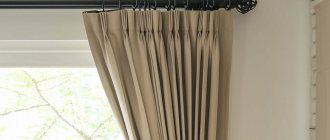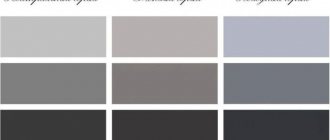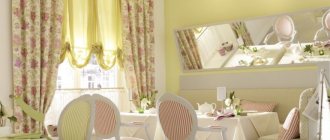Windows that are not covered with curtains create the effect of some kind of incompleteness, or even “coldness” of the room. Perhaps this is acceptable in a strict office, but in your home or apartment you want a more comfortable environment. Therefore, curtains in the vast majority of cases are considered as one of the key elements of interior decoration of rooms. And if you do not take into account exotic types of window drapery, such as roller or Roman blinds or all kinds of blinds, then what remains is a standard, decades-tested “set” of light translucent curtains for daylight hours, and thick curtains drawn at night.
How to hang a ceiling curtain - several options for different occasions
But to hang any curtains, you need to have special curtain rods. These curtain rods can be attached to both the wall and the ceiling. In our time, ceiling curtains are more in demand, since with them the curtains look much more beautiful, almost completely breaking up the space near the window from top to bottom, without significant clearance from above, and often without it at all. And now – a small “linguistic nuance”. According to orographic dictionaries of the Russian language, light curtains are called curtains. But it just so happened that this name somehow “migrated” to their suspension system, that is, to the cornices. And when asking the search query “how to hang a ceiling curtain,” the user in the vast majority of cases expects recommendations specifically for installing a ceiling cornice. Let’s not be picky, we understood the task at hand, and we will try to reveal it in detail in this publication.
Characteristics of the ceiling cornice
The ceiling cornice, as the name suggests, is attached to the ceiling, which makes it somewhat difficult to choose between a ceiling or a regular wall-mounted model, because sometimes the ceiling cornice simply cannot be fixed in a suitable place (for example, due to a suspended ceiling). In addition to all this, ceiling cornices have a number of pros and cons that you need to know about before you finally decide which option will be preferable.
The ceiling cornice differs from the wall cornice in its location.
Features of drawstring curtains with comb
Window openings are often decorated with drawstring curtains, but this is not the only way to decorate a window. There is a similar method, which consists of an additional machine stitch that forms a comb over a pipe, fishing line, or wire. This name is not due to the association from the visual image, but rather from the schematic appearance of the pattern.
If curtains must provide a reliable barrier from the sun's rays or a screen from prying eyes, it is better to choose products made from dense materials.
Drawstring curtains come in a wide variety of design solutions.
Many housewives prefer this addition because it looks more complex and of better quality, especially with simple-looking fabrics. The main thing is just not to make a mistake with the indents and length of the canvas if you do it yourself.
If necessary, drawstring curtains can be combined with other textile products - curtains, curtains, thick drapes, lambrequins, etc.
Advantages and disadvantages
Advantages:
- The ceiling cornice creates the effect of high ceilings in the room due to the lack of horizontal division.
- With the help of such a curtain rod and matching curtains, you can decorate the room, draping the space from floor to ceiling.
- Curtains on the ceiling cornice cover the wall completely, leaving no gaps, cracks or unclosed holes.
- Variety of designs - cornices can be completely different, you can choose invisible, neutral or having a decorative strip/face molding (it should match the interior of the room and it is this that supports the chosen style in the window design).
- The curtains on the ceiling cornice move very quickly and easily.
- There is an option for curtains with control (mechanical - pull the chain to open the curtains; automatic - press the remote control buttons to do the same).
- The ceiling cornice can have the length that is required for each specific room (one product reaches 4 meters, but several cornices can be connected using special tools).
- Ceiling cornices are very flexible, which is why they can be intricately bent and hung in this form on the window. This is done using a special lock.
Ceiling cornices have many advantages.
Flaws:
- An inconvenience during installation is that your hands must be raised to the ceiling at all times.
- It is inconvenient to drill into ceilings.
Types of fastening without cornice
- Universal fastenings for sashes (brackets). Compact fastening element, used for placing roller and pleated curtains, as well as horizontal blinds.
- Velcro. This method does not require a gap between the curtain and the wall. Suitable for rooms where complete darkness is required.
- Using self-tapping screws. Universal and simple installation method.
- Double sided tape. A practical, handy way to hang fabric and other fabrics on a window sash without drilling. Not reliable enough and unable to withstand heavy loads.
Types of ceiling cornices
Ceiling cornices can be divided into three large groups, based on the number of runners designed for curtains to move along them:
- Single row.
- Double row.
- Three-row.
These three options are the most common, although now in hardware stores you can find curtain rods with a large number of runners - from five to seven pieces.
Also, ceiling cornices differ in types of construction. They are:
- String (cable)
- Profile (tire) (here there is also a division by materials - curtain rods are plastic and aluminum).
Their design is quite light: two fastenings (brackets), a thin cord made of steel or nylon for sliding the hooks. The number of cords is usually from one to three - this way the cornice looks better in a room decorated in a minimalist style, and this design is invisible and is very inexpensive.
The profile cornice is equipped with a plastic or aluminum body with grooves-rails formed inside, into which special hooks and runners are inserted (they have rotating wheels, which makes the design more expensive). Curtains are attached to hooks or runners.
The profile cornice consists of grooves and fasteners.
Sometimes you can find a regular cornice with a pipe, which follows the shape of the wall one, but is attached to the ceiling.
Often an ordinary cornice in the form of a pipe is attached to the ceiling.
There are also baguette ceiling cornices with rounded edges. They are usually used for windows located on long walls when the curtains do not need to cover the entire wall space. When the window is closed with curtains, there is a certain feeling of incompleteness of the view, which may not please everyone. To improve the situation a little, baguette cornices with rounded corners were invented.
There are baguette cornices that have rounded edges.
Mounting options
- Ceiling. One of the most common installation locations. Ideal for rooms with low ceilings.
- Wall. A classic place to hang curtains. Almost any fastening element can be mounted on it. This format is mainly used for heavy and fabric canvases.
- Casement. More often, roller, Roman and bamboo models are placed on it, as well as textile and metal blinds.
- Frame. As with the previous option, it involves placing miniature curtains that can be conveniently folded.
The photo shows hourglass curtains mounted on a window sash.
How to choose the right one
To choose the right ceiling cornice, you must first decide what function it will perform: decorative or only functional.
If we are talking not only about the function of the cornice, but also about its use as a room decoration, then you should choose a model with a decorative strip, or, as it is also called, with face molding. Typically, such a strip is glued to a special adhesive tape provided on the cornice, or inserted into a groove originally made in the structure.
Cornices with decorative strips serve as interior decoration.
If there is adhesive tape on the cornice, you can sew a decorative strip yourself from decorative material or curtain fabric so that everything looks organic. If grooves are made in the design of the cornice, then you need to insert a plastic strip into them, which can either be included in the kit or purchased separately.
Window design options
- The use of a drawstring in an arched window opening looks unusual. It looks sophisticated and tasteful, not banal.
- If you use light translucent curtains in the house, on the north side, where the sun does not shine intensely, then the material will diffuse the existing light and visually distribute it. This will add an atmosphere of mystery and lightness to the interior.
If you need to decorate a tall or standard window, it is customary to use floor-length curtains.
- In a children's room, curtains and tulle with drawstrings will be very useful, as they provide greater practicality. Hooks tend to break, pop out and become deformed, but here everything will remain intact for a long time.
- Stylistically, the drawstring is suitable for kitchen curtains, especially it has a hint of Country style. With the right choice of color and material, it can turn out very lively, stylish and fresh.
When decorating small windows and windows of non-standard shapes, curtains up to the window sill are most often used.
In any case, this option can only fail when trying to recreate strict English classics. After all, assembly and drapery are about lightness, comfort and coziness, but not about impeccably clear lines.
As for the materials for creating drawstring curtains, everything depends on the style features of the interior and the functional purpose of the curtains.
How to fix the cornice
To secure the ceiling cornice, you must first calculate the distances from the wall. To do this, it is worth looking at the location of the heating radiators (“radiators”) and the window sill - the more they protrude forward, the greater the indentation should be. Usually the distance between the wall and the curtain is from eight to fifteen to twenty centimeters, so that the curtains do not touch anything when moving.
First of all, you need to make the necessary measurements.
Once the indentations have been determined and recorded on the drawing, you can turn to installing the fasteners. Some models are pre-provided with mounting holes, which means you just need to install the fasteners in each of the places marked on the structure. If this is not the case, you will need to purchase additional dowels and screws yourself (the head of the screw must be at least two millimeters larger than the diameter of the hole, otherwise the curtain rod may fall under the weight of the curtains, as it will not hold well to the ceiling).
You may have to purchase some additional mounting parts.
If you need to drill holes for mounting the cornice yourself, then you should make the distance between the holes from fifty to sixty centimeters. If there are two tracks in the eaves profile, the holes should be drilled in a staggered pattern, so the load will be distributed more evenly, and the structure itself will be more reliable.
To the concrete ceiling
If you need to attach the cornice to a concrete ceiling (ceiling), then in addition to the fasteners you will need a drill and a screwdriver with a suitable slot.
Instructions on how to attach a ceiling curtain rod to a concrete ceiling.
- Adjust the length of the cornice. Cut off the excess using a special tool - a hacksaw.
- If the holes on the cornice are not drilled:
- Mark so that the distance between adjacent holes does not exceed sixty centimeters.
- Leave five to ten centimeters from the junction points.
- If necessary, stagger the holes.
- Drill holes (the drill should be equal in diameter to the size of the fasteners).
- Assemble all the parts of the cornice together.
How to secure:
- Attach the finished structure to the ceiling. Align.
- Mark the attachment points with a simple pencil.
- Drill holes for mounting.
- Insert the plastic part of the dowel into the hole so that it is flush with the ceiling.
- Attach the decorative strip into the grooves (do not glue).
- Attach the finished cornice to the marks on the ceiling.
- Install the fasteners first in the center and along the edges.
Attaching a curtain track to the ceiling (how to attach a curtain track to the ceiling)
To figure out how to attach a curtain track to the ceiling, you should always use the instructions. In general, fastening cornices to a concrete ceiling has the same technology as fastening to any other ceiling option: you need to level the structure, mark the places where the fastenings will be located, drill holes, attach the cornice again to the markings and install all the fastenings in the order of the outer ones -central-rest.
The cornice is attached to other types of ceilings in much the same way.
If the ceiling is plasterboard
If it was decided to install a ceiling cornice at the renovation stage, most likely there is a special niche in which it is installed. In this case, it is attached to the ceiling, and how to attach the ceiling cornice to concrete and wooden floors is described above. It will be a little more difficult, since freedom of action is limited, but not critical.
Attaching the cornice in a niche is a little more inconvenient
There may be a second option - without a niche. A wooden beam is fixed at the place where the cornice is installed. It is located between the drywall and the main floor. In this case, the ceiling cornice is attached to the beam through plasterboard. You need to use wood screws of sufficient length so that the body of the beam contains at least 2/3 of the length (preferably more).
But if you decide to replace the cornice with a ceiling one after the repair, you will have to look for special fasteners. These are the so-called butterfly and snail dowels. Both are characterized by an increased contact area with the material, due to which the load is distributed over a larger surface. But it’s still better not to use heavy fabrics.
Using special fasteners for drywall
How to hang curtains on a ceiling cornice
To hang curtains on a ceiling cornice, you first need to know how to measure curtains correctly: you need to measure the length of the curtains from the bottom edge of the cornice to the floor, leaving a margin for sewing the tape to the top of the curtain fabric. It is needed because such a tape always has pre-made loops that can be used when attaching the curtain to the hooks.
How to hang curtains on a ceiling cornice, two ways:
- Attach the hooks to the tape, tuck them into the grooves, install a stopper and a plug.
- Tuck the hooks or runners into the groove, install the stopper and plug. Then hang loops on the hooks.
Video description
About ideas for curtains with ties in the following video:
Hooks
Hooks are a popular type of fastening due to their obvious ease of use. There are two types of hooks. The first ones (usually metal) are sewn from the inside of the panel and are equipped with rings that move freely along the cornice. The second hooks are small, plastic, which allows you to make them invisible by hiding them under a closed cornice. In this case, loops are sewn to the curtain.
Hooks in a Mediterranean interior Source art-interior.moscow
Fastenings for curtains in the form of hooks are hidden from view, so they do not affect the appearance of the window decor. This is ideal for attaching curtains to a flat cornice. Hooks will hold curtains made of any fabric except the heaviest ones. When choosing this fastener for the cornice, purchase clamps that prevent the hooks from slipping.
Their advantages include low cost, easy installation and reliable operation. The downside is that the fastening is not one of the most aesthetically pleasing, plastic hooks break, and metal ones make a fair amount of noise when moving along the eaves.
Airy muslin on hooks Source hzcdn.com
Window decoration with curtains on the ceiling cornice
Why choose ceiling cornices? Firstly, with the help of curtains hanging on the ceiling cornice, you can beautifully drape the surface of a wall or window. Secondly, such curtains cover all defects of the window opening and the window itself. And finally, thirdly, floor-to-ceiling curtains cover the entire window, leaving no gaps. Therefore, the choice of curtains is very important - they should match the decoration of the room, the curtain rod and be beautiful enough to become another striking black room.
Ceiling cornice is becoming increasingly popular in the market of building materials for the home and this is not surprising, because thanks to the ceiling cornice you can greatly decorate any room.
Methods for attaching curtains
- To the cornice. Classic placement of fabrics. There is a large selection of similar products on the modern market. They differ in shape, assembly, material and color scheme. The structure can be attached to both the wall and the ceiling.
- Fastening systems without cornice. If the design does not include cornices, then the curtains are attached directly to the windows, ceiling or wall. Iron or transparent PVC hooks, rigid rope, adhesive tape and even a dry treated branch can be used as accessories. There are no restrictions here, everything depends on the designer’s imagination.
The photo shows a bedroom with an unusual window opening design, where eyelet holders are attached directly to the wall.
Instructions for installing a curtain rod on a wall
It happens that people first make repairs in a room, and only after its completion they begin to think about how to attach the cornice to the ceiling surface. In this case, the embedded supports are not installed.
Well, there are not many options left, and mounting to the ceiling is no longer considered. Now it's time to learn how to attach ceiling cornices to the wall.
Mounting methods:
- Use brackets, selecting them according to the width of the cornice and connecting them with self-tapping screws.
- Attach a mounting wooden beam to the wall under the ceiling and attach the cornice to it. Please note that this structure will still need to be decorated somehow.
Attaching the ceiling cornice to the wall
